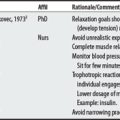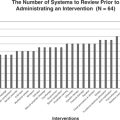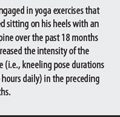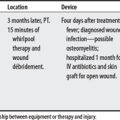Chapter 32 Prosthetics
OVERVIEW.
A prosthesis is an artificial mechanical or electrical body part used to replace a missing one; the word literally means “placed instead.”1
SUMMARY: CONTRAINDICATIONS AND PRECAUTIONS.
Overall, prosthetic sources will often indicate whether patients are poor candidates for prosthetic training; contraindications are not frequently listed. Gitter and Bosker2 indicate that a prosthetic candidate should have a reasonable cardiovascular reserve, adequate wound healing, good soft tissue coverage, sufficient range of motion and strength, motor control, and learning ability to use the prosthesis. With borderline cases, less costly trials (e.g., rigid dressing [removable] with pylon and foot) can be considered. Based on an older, 1977 retrospective review, Couch3 identified dementia and debility as two contraindications for a prosthesis. Depending on the type of prosthesis, other concerns include skin grafts, skin hypersensitivity, short stump length,3 blindness,3 and commitment to the rehabilitation process. General prosthetic concerns as well as guidelines for ICEROSS Socket Systems and Patella Tendon Bearing Socket are noted below.
CONTRAINDICATIONS AND PRECAUTIONS
PROSTHESES: GENERAL
E00-E90 ENDOCRINE NUTRITIONAL AND METABOLIC DISEASES
F00-F99 MENTAL AND BEHAVIORAL DISORDERS
G00-G99 DISEASES OF THE NERVOUS SYSTEM
I00-I99 DISEASES OF THE CIRCULATORY SYSTEM
J00-J99 DISEASES OF THE RESPIRATORY SYSTEM
M00-M99 DISEASES OF THE MUSCULOSKELETAL SYSTEM AND CONNECTIVE TISSUE
S00-T98 INJURY, POISONING, AND CERTAIN OTHER CONSEQUENCES OF EXTERNAL CAUSES
1 Eisenberg MG. Dictionary of rehabilitation. New York: Springer, 1995.
2 Gitter A, Bosker G. Upper and lower extremity prosthetics. Delisa JA, editor. Physical medicine and rehabilitation: principles and practice, ed 4, vol 1. Philadelphia: Lippincott Williams & Wilkins, 2005.
3 Couch NP, David JK, Tilney NL, et al. Natural history of the leg amputee. Am J Surg. 1977;133(4):469-473.
4 Tan JC. Practical manual of physical medicine and rehabilitation: diagnostics, therapeutics, and basic problems. St. Louis: Mosby, 1998.
5 McCurdie I, Hanspal R, Nieveen R. ICEROSS—a consensus view: a questionnaire survey of the use of ICEROSS in the United Kingdom. Prosthet Orthot Int. 1997;21(2):124-128.
6 Engstrom B, Van de Ven C. Physiotherapy for amputees: the Roehampton approach, ed 2. Edinburgh, Scotland: Churchill Livingstone, 1993.

























